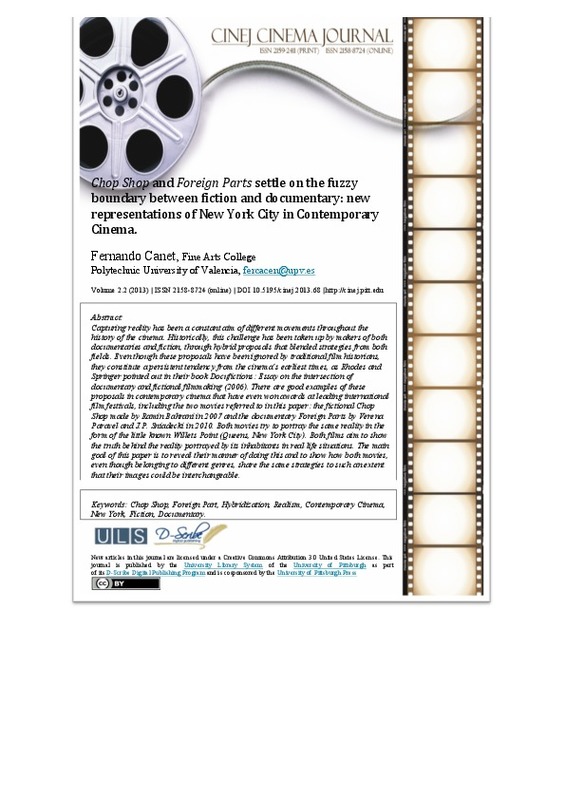JavaScript is disabled for your browser. Some features of this site may not work without it.
Buscar en RiuNet
Listar
Mi cuenta
Estadísticas
Ayuda RiuNet
Admin. UPV
Chop Shop and Foreign Parts settle on the fuzzy boundary between fiction and documentary: new representations of New York City in Contemporary Cinema
Mostrar el registro sencillo del ítem
Ficheros en el ítem
| dc.contributor.author | Canet Centellas, Fernando Javier
|
es_ES |
| dc.date.accessioned | 2015-06-02T09:42:45Z | |
| dc.date.available | 2015-06-02T09:42:45Z | |
| dc.date.issued | 2013 | |
| dc.identifier.issn | 2158-8724 | |
| dc.identifier.uri | http://hdl.handle.net/10251/51108 | |
| dc.description.abstract | Capturing reality has been a constant aim of different movements throughout the history of the cinema. Historically, this challenge has been taken up by makers of both documentaries and fiction, through hybrid proposals that blended strategies from both fields. Even though these proposals have been ignored by traditional film historians, they constitute a persistent tendency from the cinema s earliest times, as Rhodes and Springer pointed out in their book Docufictions: Essay on the intersection of documentary and fictional filmmaking (2006). There are good examples of these proposals in contemporary cinema that have even won awards at leading international film festivals, including the two movies referred to in this paper: the fictional Chop Shop made by Ramin Bahrani in 2007 and the documentary Foreign Parts by Verena Paravel and J.P. Sniadecki in 2010. Both movies try to portray the same reality in the form of the little known Willets Point (Queens, New York City). Both films aim to show the truth behind the reality portrayed by its inhabitants in real life situations. The main goal of this paper is to reveal their manner of doing this and to show how both movies, even though belonging to different genres, share the same strategies to such an extent that their images could be interchangeable. | es_ES |
| dc.language | Inglés | es_ES |
| dc.publisher | University of Pittsburgh, University Library System | es_ES |
| dc.relation.ispartof | CINEJ Cinema Journal | es_ES |
| dc.rights | Reconocimiento (by) | es_ES |
| dc.subject | Chop Shop | es_ES |
| dc.subject | Foreign Part | es_ES |
| dc.subject | Hybridization | es_ES |
| dc.subject | Realism | es_ES |
| dc.subject | Contemporary Cinema | es_ES |
| dc.subject | New York | es_ES |
| dc.subject | Fiction | es_ES |
| dc.subject | Documentary | es_ES |
| dc.subject.classification | COMUNICACION AUDIOVISUAL Y PUBLICIDAD | es_ES |
| dc.subject.classification | BIBLIOTECONOMIA Y DOCUMENTACION | es_ES |
| dc.title | Chop Shop and Foreign Parts settle on the fuzzy boundary between fiction and documentary: new representations of New York City in Contemporary Cinema | es_ES |
| dc.type | Artículo | es_ES |
| dc.identifier.doi | 10.5195/cinej.2013.68 | http://cinej.pitt.edu | |
| dc.rights.accessRights | Abierto | es_ES |
| dc.contributor.affiliation | Universitat Politècnica de València. Departamento de Comunicación Audiovisual, Documentación e Historia del Arte - Departament de Comunicació Audiovisual, Documentació i Història de l'Art | es_ES |
| dc.description.bibliographicCitation | Canet Centellas, FJ. (2013). Chop Shop and Foreign Parts settle on the fuzzy boundary between fiction and documentary: new representations of New York City in Contemporary Cinema. CINEJ Cinema Journal. 2(2):39-50. doi:10.5195/cinej.2013.68 | http://cinej.pitt.edu | es_ES |
| dc.description.accrualMethod | S | es_ES |
| dc.relation.publisherversion | http://dx.doi.org/10.5195/cinej.2013.68 | es_ES |
| dc.description.upvformatpinicio | 39 | es_ES |
| dc.description.upvformatpfin | 50 | es_ES |
| dc.type.version | info:eu-repo/semantics/publishedVersion | es_ES |
| dc.description.volume | 2 | es_ES |
| dc.description.issue | 2 | es_ES |
| dc.relation.senia | 263935 | |
| dc.identifier.eissn | 2158-8724 |








